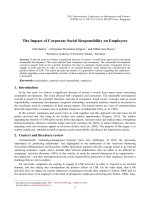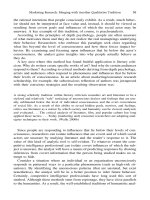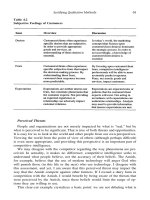Corporate Social Responsibility The New Strategic Marketing Battle pot
Bạn đang xem bản rút gọn của tài liệu. Xem và tải ngay bản đầy đủ của tài liệu tại đây (141.65 KB, 10 trang )
Corporate Social Responsibility
The New Strategic Marketing Battleground
by
Chris Maloney
SMASHWORDS EDITION
Copyright © 2010 Chris Maloney
Smashwords Edition, License Notes
This ebook is licensed for your personal enjoyment only. This ebook may not be re-sold or given away to
other people. If you would like to share this book with another person, please purchase an additional copy
for each recipient. If you’re reading this book and did not purchase it, or it was not purchased for your use
only, then please return to Smashwords.com and purchase your own copy. Thank you for respecting the
hard work of this author
Chapter 1: What is Corporate Social Responsibility (CSR)?
A widely used definition of Corporate Social Responsibility comes from the World Business Council for
Sustainable Development who states that it is the “continuing commitment by business to behave
ethically and contribute to economic development while improving the quality of life of the workforce,
their families and the local community and society at large. (World Business Council for Sustainable
Development 1999)
The Corporate Responsibility Index (2007) states that Corporate Social responsibility is achieved when “a
business adapts all of its practices to ensure that it operates in ways that meet, or exceeds, the ethical,
legal, commercial and public expectations that society has of business.”
Corporate Social Responsibility is closely related to ideas such as sustainability, corporate citizenship, the
triple bottom line, socially responsible investment, and corporate governance. (The Prime Ministers
Community Business Partnership 2007) It can be measured using instruments such as the Corporate
Responsibility Index and the Dow Jones Sustainability Index.
In recent times, a number of corporate frauds (e.g. Enron, HIH) have demonstrated that a singular goal of
profit maximization can lead to unethical conduct. Chakraborty et al (2004) showed that a profit
maximization focus can trigger a variety of unethical practices including: bribery; deceptive advertising;
launching unsafe products; creative accounting; and withholding information from shareholders and the
public. The negative outcomes of a shareholder focus only have given rise in importance of corporations
considering all stakeholders via Corporate Social Responsibility.
Chapter 2: Why should business engage in Corporate Social Responsibility?
There are several benefits of engaging in Corporate Social Responsibility and each of these is looked at in
turn below.
Improved financial performance
In a literature review on the topic, Gardberg and Fombrun (2006) found that most empirical studies
“focused heavily on demonstrating a link between social performance (CSR) and financial performance
with the majority claiming to have uncovered a systematic link between the two.”
Luo & Battacharya (2006) found that “Corporate Social Responsibility contributes positively to market
value suggesting that managers can obtain competitive advantages and reap more financial benefits by
investing in Corporate Social Responsibility”. Their study specifically uncovered that for “a typical
company with an average market value of approximately $48 billion, a one unit increase of Corporate
Social Responsibility ratings would result in approximately $17 million more profits on average in
subsequent years”
Reduced exposure to reputational risk
A corporate reputation is often built over decades, but can be destroyed in an instant through corruption
scandals or environmental accidents (Wikipedia 2007). Examples of reputational breakdowns include
Union Carbide in India and Big Tobacco in the US (Chakraborty et al 2004). Engaging in Corporate
Social Responsibility can offset these reputational risks.
Enhanced brand image and corporate reputation via positive PR
Positive media coverage due to Corporate Social Responsibility adds value to the brand and corporate
reputation. Philanthropy and other social activities (excluding cause-related) have “a high position impact
on relationship and social measures of performance” according to Chahal and Sharma (2006)
Campbell and Slack (2006) found that the “rate of charitable giving against profit is found to respond
positively to public visibility.” This study suggests that corporations with high visibility (often consumer
brands) are more likely than low visibility corporations to engage in philanthropy to improve their
corporate reputation in the eyes of society.
Corporate Social Responsibility can also assist in building differentiation from competitors. A good
example of this benefit is The Body Shop. By focusing on Corporate Social Responsibility companies can
maintain long-term relationships with stakeholders and build strong brand image and competitive
advantage, which is difficult to imitate (Aaker, 1996).
Increased customer loyalty
Customers now have increased access to information and this increases the risk of companies being found
out for unethical practices. For example, criticisms of Nike’s operations in Asia in the 1990s forced the
company to alter its manufacturing processes. In order to redeem its strong customer loyalty, Nike
changed many of its labor, environmental and reporting practices, and regularly insists on independent
inspections of local subcontractors. (Gardberg and Fombrun 2006).
Luo & Battacharya (2006) found that Corporate Social Responsibility “increases customer satisfaction
which in turn leads to positive financial returns”. They suggest that building customer satisfaction is an
“important intermediate step in converting Corporate Social Responsibility into financial gains.”
Improved culture and recruitment, motivation and retention of staff
Chahal and Sharma (2006) found that “the degree of organization culture and ethical values has a positive
impact on economic performance (profitability, market share and sales volume); relationship performance
(employees, channel members and consumers satisfaction and retention) and social performance
measures (social return on investment (SROI).
In addition to improving culture, Corporate Social Responsibility has positive impacts on staff
recruitment and retention. McKeon (2006) stated that “employees expect their employer to have an
enlightened attitude to the community”. Chakraborty et al (2004) showed that Corporate Social
Responsibility results in “a bonus in terms of stronger staff bonding with the organisation and stronger
motivation. This can be converted into higher productivity, better product quality, better and faster
implementation of the needed changes and innovations”
Esquel Group, part of the apparel industry with most of its employees in the Asia Pacific, is a good
example of the positive effects of Corporate Social Responsibility on staff. Esquel Group’s core strategy
is to create an “eCulture”. The eCulture refers to ethics, environment, exploration, excellence, and
education, all of which are key elements of Corporate Social Responsibility. As a result progress has been
made in terms of “increased productivity, diversity and learning and talent depth”. (Bell 2005).
Improved government relations and reduced regulatory intervention
Gardberg and Fombrun (2006) found that “in emerging markets, governments often award privileged
contracts to global companies because of their superior reputations” for Corporate Social Responsibility.
There is a high expectation with these contracts that the multinational companies will contribute to the
local community and economic development.
Assists multinationals in overcoming the liability of foreignness in new markets
Gardberg and Fombrun (2006) also argued that Corporate Social Responsibility is a “strategic investment
comparable to R&D and advertising which can create intangible assets that help companies overcome
nationalistic barriers, facilitate globalization, and out compete local rivals.”
Corporate Social Responsibility therefore enables global companies to operate across diverse local
markets through providing “legitimacy, reputation, and competitive advantage to overcome a liability of
foreignness, which refers to the cost incurred by foreign subsidiaries in excess of those of their domestic
counterparts.”
Chapter 3: What should businesses be aware of when engaging in Corporate Social
Responsibility?
The economist Milton Friedman (1970) argued that Corporate Social Responsibility is a distraction from
a “a corporation's principal purpose to use its resources and engage in activities that maximize returns to
its shareholders, while obeying the laws of the countries within which it works” According to Munilla and
Miles (2005), another economist Adam Smith also argued 200 years ago that “the general welfare was
better served by people pursuing their enlightened self interest than by misguided attempts to serve
society.” These ideas are contrary to that of Corporate Social Responsibility.
Despite this McKeon (2006) raises a good point in that virtually all detractors of Corporate Social
Responsibility come from the sidelines. “They tend not to be business managers trying to satisfy
shareholder expectations. Equally they tend not to represent the community sector. No the opponents tend
to be academics, consultants, members of think tanks and professional opinion writers.”
Another aspect to be aware of is that if companies talk the Corporate Social Responsibility talk, they must
walk the walk or they will be found out. For example, Shell has a much publicized Corporate Social
Responsibility policy and was a pioneer in triple bottom line reporting; however a scandal in 2004 over
the misreporting of its oil reserves seriously damaged its reputation. (Wikipedia 2007)
Chapter 4: How multinationals companies are integrating Corporate Social
Responsibility in their strategy to build and sustain a competitive advantage.
Chakraborty et al (2004) stated that while “the World Trade Organisation is giving undreamt of freedom
to businesses, they also greatly increasing their Corporate Social Responsibility.” Particularly in
developing countries, multinationals are expected to go beyond earning just profit for the shareholders to
become primary engines of growth, job creation, innovation, and exports.
Michael Porter said that “corporations can use philanthropy to improve their competitive context”.
Corporate philanthropy is defined as “the act of corporations donating a portion of their profits or
resources to a nonprofit cause or organization” (Milam, 2005). According to Wyner (2006) corporate
philanthropy is exhibited in three general categories: corporate giving via cash or non cash donations to
non for profit organisations; philanthropic sponsorships, and; cause-related marketing which generally
links a corporate donation to product sales.
Corporate philanthropy is a key aspect of Corporate Social Responsibility for multinational organisations.
Miles and Covin (2000) developed a Corporate Social Responsibility framework that proposed “that firms
tend to relate to environmental management either by mere compliance or strategically leveraging CSR as
a means to create and renew competitive advantage.” Munilla and Miles (2005) stated that “the strategic
perspective can be used as a foundation for building competitive advantage by both enhancing firm
efficiency and, simultaneously, increasing the value of the firm’s market offering to specific market
segments.”
The framework can be broken down into a continuum based on the source of competitive advantage
derived from Corporate Social Responsibility expenditures. This continuum goes from compliance
(“perceived as a cost of doing business”), to strategic (“perceived as an investment in the firm’s set of
distinctive competencies”), to forced (“perceived as a “tax” being mandated by NGOs or other external
stakeholders that will diminish the firm’s ability to create value for shareholders”) (Munilla & Miles
2005)
Compliance Corporate Social Responsibility
Exxon is an example of a company that takes the compliance perspective. The Economist (2003) notes
that Exxon’s efforts are focused on “generating the highest sustainable economic returns possible for
shareholders and intentionally avoiding budgeting for non-mandated environmental and social issue
expenditures.” This compliance approach to CSR has helped Exxon deliver better financial returns than
its main competitors.
Strategic Corporate Social Responsibility
Westpac is an example of a multinational (Australia, New Zealand, and the Pacific) corporation taking a
more strategic stakeholder approach to Corporate Social Responsibility. In a recent 2006 brand
advertising campaign, Westpac revealed a new corporate slogan: “every generation should live better than
the last”. The Westpac website states that “at Westpac, we believe that the best decisions are ones that not
only work towards a sound financial future but also work towards a more responsible future for the
community and our environment.”
In order to help every generation live better than the last, Westpac have undertaken several initiatives. In
2003, Westpac became one of only ten banks worldwide, and the only Australian bank to adopt the
Equator Principles. “The Equator Principles provide a framework to ensure project loans are only
provided to sponsors that can demonstrate their ability and willingness to ensure projects are developed in
a socially responsible manner, following sound environmental management policies” (Westpac website
2007).
Westpac engages in philanthropic sponsorships of rescue services and surf life saving. They also use
cause-related marketing through discounts on a range of energy-friendly products and services, such as
cash back on solar panels if you have a Westpac home loan. Westpac reduces paper wastage by providing
customers with the opportunity to move to electronic statements.
Finally, Westpac engages in corporate giving through getting staff involved with the Generation W
volunteer bus. “In the past year, two thirds of our employees undertook some form of community
volunteer work, and around one third participate in mentoring programs or use their work-related skills to
benefit community organisations.” (Westpac website 2007).
Westpac have been rewarded for their Corporate Social Responsibility efforts by being named the number
one global bank in the Dow Jones Sustainability Index (DJSI) for the last five years. This award confirms
that Westpac are integrating Corporate Social Responsibility in their strategy and consequently building a
sustainable competitive advantage.
The Body Shop is another global corporation who takes the strategic approach to Corporate Social
Responsibility. The Body Shop promotes products under the philosophy of "profits with principles"
(Dowling 2004). This is today still a differentiating positioning in the cosmetic market.
Forced Corporate Social Responsibility
According to Munilla and Miles (2005), in some cases, particularly for multinational firms, there will be
“pressure from non government organisations or other external stakeholders to take a certain position with
respect to Corporate Social Responsibility”.
For example, Exxon were recently working in Africa (Chad) on a large oil and pipeline project. During
this $3.5 billion project, Munilla and Miles (2005) note that “Exxon was pressured by environmental and
human rights NGOs to invest in schools, public health clinics, management assistance to local
entrepreneurs, and even pay for local ritual chicken sacrifices, expenditures that Exxon would not
normally undertake.”
However, the preferences of Western NGOs who Exxon were attempting to appease were in conflict with
the local residents. Useem (2002) remarked that “the NGOs wanted Cameroon’s rain forests untouched
whereas local farmers plead for Exxon to clean them with chain saws. The NGOs wanted roads routed
around villages, whereas villagers would sneak out at night to move road markers closer to their homes.”
A forced position on Corporate Social Responsibility is not an approach to building and sustaining
competitive advantage. (Munilla & Miles 2005)
Chapter 5: Conclusion
Most multinationals companies engage in some form of Corporate Social Responsibility. However those
taking the compliance or forced perspective are less likely to build sustainable competitive advantages,
other than just making extraordinary short term profits, when compared to those taking the strategic
perspective. A strategic approach to Corporate Social Responsibility involves a combination of corporate
giving, philanthropic sponsorships and cause related marketing.
Chapter 6: References
Aaker, D.A. (1996) Building Strong Brands, New York, The Free Press.
Bell, A. 2005, ‘The employee value proposition redefined.’, Strategic HR Review; May/Jun2005, Vol. 4
Issue 4, p3
Campbell, D. and Slack, R 2006, ‘Public visibility as a determinant of the rate of corporate charitable
donations’. Business Ethics: A European Review; January 2006, Vol. 15 Issue 1, p19-28
Chahal, H. & Sharma, R. D. 2006 ‘Implications of corporate social responsibility on marketing
performance: A conceptual framework’. Journal of Services Research; April-September 2006, Vol. 6 Issue
1, p205-216
Chakraborty, S.K, Kurienn, V., Singh, J. Athreya, M. Maira, A. Aga, A. Gupta, A.K, ‘Management
Paradigms Beyond Profit Maximisation’, Vikalpa, Volume 29, No 3 July – September 2004, pp97-117
Chaudhri, V.A. 2006, ‘Organising Global CSR’. Journal of Corporate Citizenship; Autumn 2006 Issue
23, p39-51
Corporate Responsibility Index 2007, ‘Why business should engage in corporate social responsibility’,
viewed 3 April 2007,
< />Dowling, G.R. 2004, ‘Corporate reputations: should you compete on yours?,’ California Management
Review; Spring2004, Vol. 46 Issue 3, p19-36, 18p
Friedman, M. 1970, ‘The Social Responsibility of Business is to Increase its Profits’, The New York Times
Magazine, September 13, 1970.
Gardberg, N.A. & Fombrun, C.J. 2006, ‘Corporate citizenship: creating intangible assets across
institutional environments.’ Academy of Management Review; Apr2006, Vol. 31 Issue 2, p329-346
Luo, X. & Bhattacharya, C.B. 2006, ‘Corporate Social Responsibility, Customer Satisfaction, and Market
Value.’ Journal of Marketing; Oct2006, Vol. 70 Issue 4, p1-18
Malan, D. 2005 ‘Corporate Citizens, Colonialists, Tourists or Activists?’ Journal of Corporate
Citizenship; Summer 2005 Issue 18, p49-60
Maghrabi, A.S. 2006 ‘Compelling Claims on Multinational Corporate Conduct’. Journal of American
Academy of Business, Cambridge; Mar2006, Vol. 8 Issue 2, p307-312,
Marshall, J & Heffes, E.M. 2007, ‘New Group Pushes 'Responsibility Officer'’ Financial Executive;
Jan/Feb2007, Vol. 23 Issue 1, p11
McKeon, S. 2006, ‘Corporate social responsibility makes an impact’, The Age, August 31, 2006, viewed 3
April 2007 < />impact/2006/08/30/1156816967880.html>
Milam J. 2005, ‘Corporate Giving’, Learning to Give. viewed on 3 April 2007 <www.leamingtogive.org/
papers/index.asp?bpid=17.>
Miles, M.P & Covin, J.G. 2000. “Environmental marketing: A source of reputational, competitive, and
financial advantage.” Journal of Business Ethics, Issue 23, p299-311
Munilla, L.S. & Miles, M.P. 2005 ‘The Corporate Social Responsibility Continuum as a Component of
Stakeholder Theory.’, Business & Society Review; Winter 2005, Vol. 110 Issue 4, p371-387
The Economist 2003, “The Unrelenting Oilman: Face value”, March 15
The Prime Ministers Community Business Partnership 2007, ‘CSR Defined’, viewed 3 April 2007,
< />Useem, J. 2002. “Fortune 500: no.2 Exxon’s African adventure”. Fortune, Issue 145, p102-110
Westpac 2007, ‘every generation should live better than the last’, viewed 3 April 2007,
<>
Wikipedia 2007, Corporate social responsibility, viewed 3 April 2007, <
Corporate_social_responsibility>
World Business Council for Sustainable Development 1999, ‘Corporate Social Responsibility: Meeting
Changing Expectations’, 1 March 1999, viewed 3 April 2007
< />Wymer, W 2006, ‘Special issue on corporate philanthropy’, International Journal of Nonprofit &
Voluntary Sector Marketing; February 2006, Vol. 11 Issue 1, p1-2
World Economic Forum. 2003. Global competitiveness reports 2003–4. <>,
viewed 3 April 2007.









